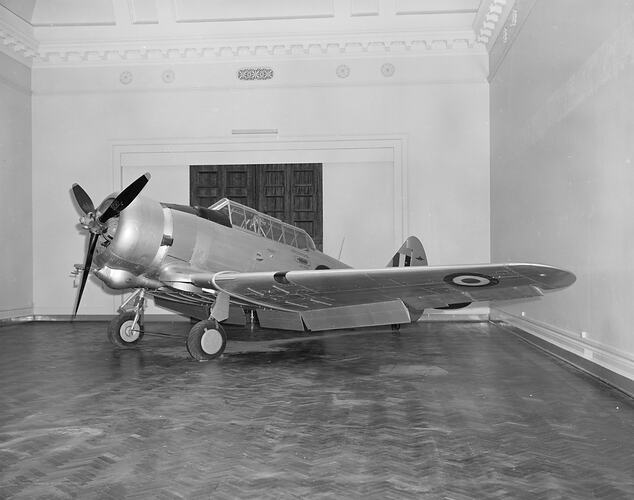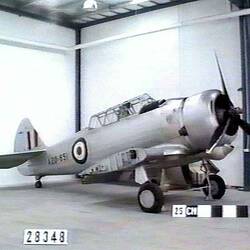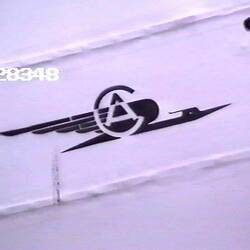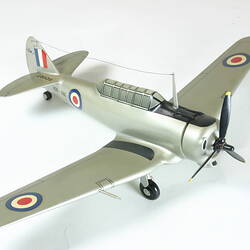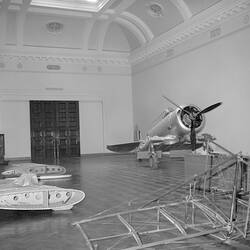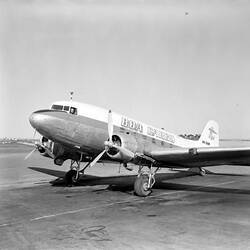Summary
Late-production CA-16 version of the CAC Wirraway Australian-made military trainer, with the CAC construction no.1103 and the RAAF serial no.A20-651. This aircraft was built at Fishermans Bend and delivered to the Royal Australian Airforce (RAAF) in June 1944, with an all-over yellow paint finish. It served with Nos.2 and 8 Operational Training Units at Mildura and Parkes respectively. Both these units were fighter conversion OTUs for pilots transitioning from Wirraways to Spitfires, Kittyhawks and (from 1945) Mustangs. It later served with 87 Squadron as a communications/training aircraft and was repainted in a post-war silver paint finish. This unit was equipped with Mosquito aircraft in the photographic survey role. After a period of storage at Tocumwal, NSW, was purchased back by CAC for use in the Ceres crop-duster program but was not converted and was donated to the Museum in 1966. Last recorded total flying hours for this machine are 363.15 in March 1954.
The aricraft was on loan to the Australian Museum of Flight at HMAS Albatross (naval base), Nowra, New South Wales, Australia, from June 2002 until March 2010. The identity of the borrowing venue reverted to its previous title, RAN Fleet Air Arm Museum, in 2007.
Aircraft Type History:
Australia's defence capability was a matter of serious concern by the mid-1930s as Japanese military aggression in China signalled confrontation with the western powers. Australia had no domestic aircraft mass-production capacity until the Commonwealth Aircraft Corporation was formed in 1936 by a syndicate of leading businesses such as BHAS, BHP, ICI and General Motors-Holden to manufacture aircraft for the RAAF. A delegation led by Lawrence Wackett toured aircraft factories in the UK, Europe and North America to find a suitable design for local production. Wackett's team recommended the two-seat North American NA-16 monoplane. The selection of a US design caused political problems for the Lyons government which preferred British aircraft for the RAAF. Increasing problems with obtaining supply of aircraft from Britain and the lack of a suitable British design forced the government to accept the inevitable and order the locally produced NA-16. A factory was built in Lorimer Street, Fisherman's Bend, Port Melbourne. By the time production began in 1938, the NA-33 design had been substituted as a more advanced design including retractable undercarriage among other refinements. The name Wirraway (said to be an aboriginal word for 'challenge') was selected in April 1938. The first production aircraft flew in March 1939. The outbreak of World War II in September 1939 led to a massive expansion of the RAAF and orders for several hundred Wirraways were placed to provide training machines for the Empire Air Training Scheme. The Pratt & Whitney R-1340 Wasp for the Wirraway was also built in Australia by CAC at Lidcombe, NSW. A total of 755 Wirraways were built between 1939 and 1946.
Although designed as a training aircraft, the lack of any suitable altenative forced the Wirraway to be used for a variety of other roles such as army cooperation and air defence. The war against Japan led to tragic episodes such as the defence of Rabaul in January 1942 where all the Wirraways of 24 Squadron were shot down by Japanese fighters or destroyed on the ground with heavy loss of life. Only one Wirraway pilot ever succeeding in shooting down a Japanese aircraft when Pilot Officer John Archer of 4 Squadron surprised a Japanese fighter near Buna in New Guinea and it crashed in shallow water. Wirraways continued to be used in New Guinea and Bougainville as army cooperation arcraft where they performed well. Most Wirraways, however, served in Australia as advanced training aircraft. The RAAF continued to use the Wirraway as a trainer until 1959. In 1958 CAC developed a crop-duster version of the Wirraway known as the Ceres and 21 were built using converted Wirraway airframes.
More Information
-
Collecting Areas
-
Acquisition Information
Donation from Commonwealth Aircraft Corporation, 05 Oct 1966
-
Manufacturer
Commonwealth Aircraft Corporation, Fishermans Bend (Fishermen's Bend), Greater Melbourne, Victoria, Australia, 1944-1955
-
User
-
Brand Names
-
Classification
-
Category
-
Discipline
-
Type of item
-
Overall Dimensions
900 cm (Length), 390 cm (Width), 400 cm (Height)
Measurements are with wings off - they measure - L-570,, W-1200,, H - 2500
-
Dimensions
8.44 m (Length), 13.1 m (Width)
Measurement From Conservation.
-
Dimensions
890 cm (Length), 884 cm (Width), 245 cm (Height)
Measurement From Conservation.
-
Keywords
Aeroplanes, Military Aircraft, Wars & Conflicts, World War II, 1939-1945
